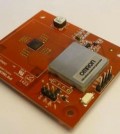7 fellows & 7 thoughts about Moore’s Law – ‘Moore’s Law is primarily an economic law, but given some expansion it can also be applied to thin-film electronics’

Most people know Moore’s Law as ‘the number of transistors on a chip doubles every two years’. That interpretation was the consequence of economic considerations. Moore predicted that ‘the number of transistors on a chip will rise exponentially if the surface area stays the same, because that way the cost per unit of computing power for integrated transistors will decrease exponentially over time’.
In my field of expertise – thin-film electronics – we don’t have the same on trying to create smaller transistors as the conventional silicon electronics domain. We started out using 10 micrometer transistors, and have evolved towards 5 and 2 micrometer. Maybe someday we will move to 0.5 micrometer transistors. Hence Moore’s Law, which is inherently tied to transistor scaling, isn’t directly applicable for thin-film electronics. And yet, I strongly believe that a scaling law will come in to play in my field. But instead of Moore’s Law, we should look instead at Wright’s Law. In the 1930s, some 30 years before Moore, Wright posited that the cost of a product falls with cumulative production. In other words, the more we make of a product, the better we become at making it and so production costs drop. You could even say that Moore’s Law is a specific case of Wright’s Law for transistors and electronics products.
Currently, thin-film electronics is facing a classic “chicken-and-egg” situation: it needs volume production to make production costs reasonable, but it needs low production costs before it is manufactured and used in high volumes. Components like thin-film based RFID-tags are set to become a major force in enabling the Internet of Things. By adding cheap tags, you can bring intelligence to everyday objects. Billions of labels will be needed. In the industry, we are trying to find a way to trigger Wright’s Law by bundling together all the various applications for thin-film electronics within the Internet of Things. This should sufficiently boost volumes for thin-film electronics, with the side effect that the price per component will fall thanks to cumulative production.
About the author
Paul L. Heremans received the PhD degree in Electrical Engineering from the University of Leuven, Belgium, in 1990. From 1984 to 1990, he was a research assistant and senior research assistant at the Belgian Fund for Scientific Research (NFWO) working on hot-carrier degradation mechanisms in CMOS. In 1990, he joined the opto-electronics group of imec. He worked on optical interchip interconnects, and on high-efficiency III-V thin-film surface-textured light-emitting diodes. In 1998, he started the organic semiconductor activities at imec. The main focus today is oxide and organic electronics, including circuits, backplanes and memories, as well as organic photovoltaics. Paul Heremans is currently imec fellow and professor at the Electrical Engineering Department of the University of Leuven. He is also director of the large area electronics department at imec, and manages the research program on “Organic and Oxide Transistors” of HOLST Centre, a collaborative research initiative by imec and TNO.
Paul Heremans, imec fellow and technology director Holst Centre/imec
Contenuti correlati
-
Imec e Cadence collaborano per il tape-out del primo chip di test a 3nm
imec, il centro di ricerca e innovazione leader a livello mondiale nel settore della nanoelettronica e delle tecnologie digitali, e Cadence Design Systems hanno annunciato che la loro lunga e consolidata collaborazione ha portato al primo tape-out...
-
7 fellows & 7 thoughts about Moore’s Law – ‘Ten years from now, CMOS will seem as old-fashioned as vacuum tubes’
I’m very optimistic about the continuation of Moore’s Law. But in saying that, I’m speaking about Moore’s Law purely as an economic law. I believe we’ll be able to offer increasing amounts of functionality at lower and...
-
7 fellows & 7 thoughts about Moore’s Law – “The Internet of Power also benefits from Moore’s Law”
It may sound strange, but striving to achieve smaller dimensions with Moore’s Law is an important enabler for producing increasingly better solar cells, with a more elaborate technology toolbox (including ALD, epitaxy, etc.). Improved process steps are...
-
7 fellows & 7 thoughts about Moore’s Law – “We must teach chips to feel pain”
When I was a doctorate student in the 1980s there was lots of wild speculation about Moore’s Law: give it another 10 years and transistors will stop getting smaller, they were saying back then. But in the...
-
7 fellows & 7 thoughts about Moore’s Law – “Wearable sensors also benefit from scaling according to Moore’s Law”
My particular area of research has nothing to do directly with Moore’s Law and advanced chip technologies. We currently use 180-nanometer technology for our health sensors. So, at first sight, you could say that in technology terms,...
-
7 fellows & 7 thoughts about Moore’s Law – “Moore’s Law will continue for a long time yet, but we will have to scale in a more ‘specialized’ way”
Moore’s Law is not a law of dimensions, but of economics. The law states that electronic systems will become increasingly smaller and increasingly cheaper and/or acquire more functions. The best example of this is our smartphone. In...
-
7 fellows & 7 thoughts about Moore’s Law – “Design techniques are helping to keep Moore’s Law alive longer”
Moore’s Law means that electronic products can constantly be produced more cheaply, faster and more economically. Down to 45 nm, this was due mainly to the technology that made it possible to reduce the size of transistors....
-
IMEC e iMinds: report finale del progetto CoPlaSM
IMEC, iMinds e i loro partner dell’iMinds ICON-project CoPlaSM hanno presentato, nel corso della European Utility Week tenutasi dal 4 al 6 novembre scorsi ad Amsterdam, i risultati del progetto biennale (avviato nel gennaio 2013) per realizzare e convalidare...
-
Imec e Omron: vibrazioni in energia elettrica
La collaborazione tra Imec e Omron ha generato un chip per raccolta di energia vibrazionale, in grado di alimentare i sensori in luoghi difficili da raggiungere. Il prototipo pesa solo 15,4 grammi per fornire corrente continua ai...
-
Un’elettronica sempre più “flessibile”
Fino ad alcuni anni fa l’impiego dei circuiti stampati flessibili era ristretto ad applicazioni piuttosto limitate, ma ora ci si sta rendendo conto che in talune applicazioni possono essere estremamente utili vantaggi quali il peso ridotto, l’adattabilità...

















